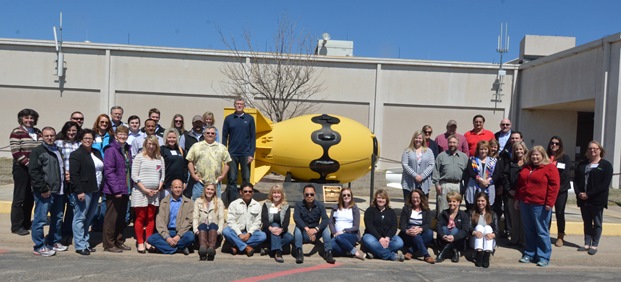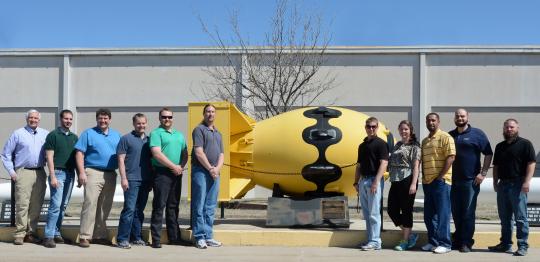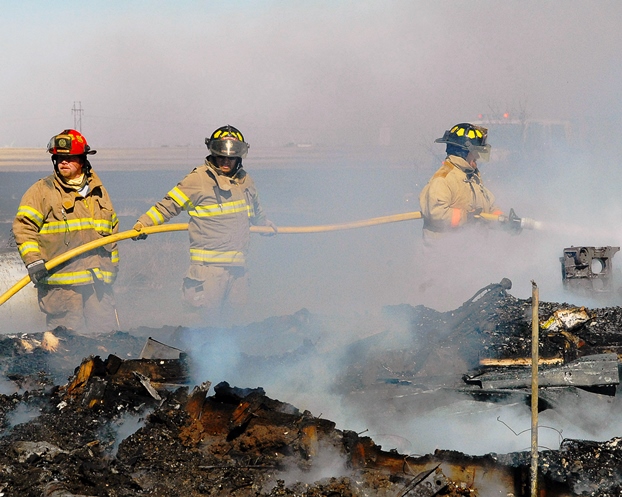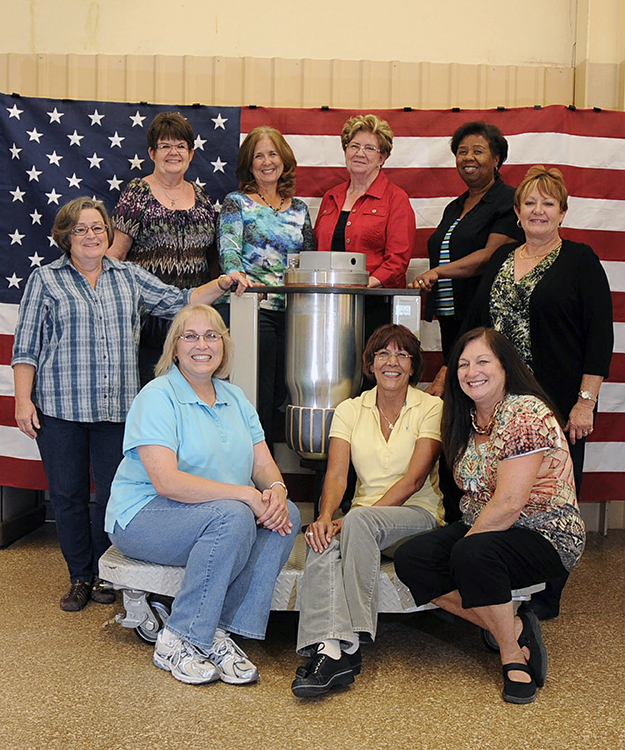Pantex Blog
Pantexans Succeed in Fitness Challenge

While they are extremely dedicated to accomplishing the important mission of the Plant, Pantexans sure don’t mind a little friendly competition. They recently participated in a Push-Up Challenge as part of the ongoing Active for Life Challenge, a 10-week American Cancer Society program to encourage employees to be more active and eat healthier foods. During the event Pantexans completed a total of 5366 push-ups and each of the 144 participants received 100 bonus points to contribute to their respective team scores.
The 25 Pantex teams are competing against each other and against teams at Y-12 National Security Complex and other DOE facilities.
The winner of the men’s competition, Geoffry Evans, completed 127 push-ups in two minutes wearing a dress shirt, slacks and a tie. Julie Herman and Savannah Gates tied the women’s competition by completing 100 push-ups each in two minutes. Many of the participants set a personal record.
Pantex Plant Hosts Leadership Amarillo & Canyon on Annual Visit

It is an annual passage of Spring in the Panhandle of Texas; trees blooming, grass greening up and members from Leadership Amarillo & Canyon making their way out to the Pantex plant northeast of Amarillo for their yearly tour of the facility.
This professional group, founded about 35 years ago is built on the strength of community leaders and business people who want to learn more about what’s happening in their own collective backyards. Designed to introduce leadership development, networking, community awareness and social consciousness to anyone wanting to make an impact in their community; they meet 10 months out of the year, experiencing a variety of businesses and industries while interacting with civic, business and non-profit agencies across the region.
This year, the group of close to 50 made its way to the main entrance building where they were greeted by Pantex Site Manager Michelle Reichert who offered up a Q&A session.
During lunch, they were introduced to Pantex Plant Agronomist Monty Schoenhals who gave an intriguing presentation on the storied history and timeline of the site. For those in attendance like Canyon City Manager, Randy Criswell, this is a rare opportunity to visit one of the area’s largest employers.
“One of the best things about this program is everything you get to see and be a part of… the familiarity with businesses and especially places like Pantex.”
After lunch the group was escorted around the perimeter of the plant along with the opportunity to get an up-close view of some of the security vehicles on one of their stops.
Then, to wrap up their day, the visitors were taken to a test firing site to experience first-hand what it looks, sounds — and feels like — to witness a planned test shot with high explosives or HE. Judging by the reaction of the crowd, it was a big hit, as was the entire tour.
Leadership Amarillo & Canyon members say they now have a better understanding of the mission here at Pantex.
“This leadership program is very diverse. It’s unique to be able to come to a place like this (Pantex) and see everything that we’re being shown. It’s something that ‘John Q Citizen’ will probably never get to see for themselves,” said Criswell.
Plans are already in the works for Leadership Amarillo & Canyon to visit Pantex again in 2016 with a new group of area leaders wanting to gain a better understanding of local businesses in the area.
Sandia Weapons Interns Visit Pantex

The current Sandia Weapons Intern Program (WIP) class recently visited NNSA’s Pantex Plant as part of the six-month program curriculum. While at Pantex, participants visited several operational facilities such as training bays, pit staging sites and firing sites. Currently there are approximately 24 participants in the WIP from various labs and sites across NNSA.
Since the program’s inception, more than 300 individuals from the nation’s weapons community have gone through the program. Through a combination of classroom study taught by active and retired weaponeers, site visits, and individual and team projects, weapon interns have honed their skills, broadened their knowledge base, and expanded their network of colleagues in the nuclear weapons community.
Panhandle Area Firefighting Brings Response from Pantex

The winds across the Texas Panhandle region are just about as famous as they are hazardous; especially for first responders battling area fires. Such was the case recently, when both volunteer and full time fire fighters joined forces to battle a blaze just a few miles from the Pantex plant, with emergency personnel from Potter County, Groom, Panhandle, and Pantex joining forces in response.
At risk: a house and its neighboring structures along with the potential hazard of a propane tank in the path of the flames. The winds whipped them up and the call for an emergency response went out. Luckily, within a very short time, the fire was out and there were no injuries reported.
Pantex maintains Memorandums of Understanding with the surrounding counties adjacent to the site and when requested, will render aid. Pantex fire and ambulance crews are on standby 24 hours a day, poised to respond to any plant emergencies and to assist surrounding municipalities through their mutual aid agreement.
For the Pantex fire department and its crew, this call was another chance to not only hone their firefighting skills, but even more, an opportunity to help out neighbors in distress. Pantex Fire Chief Mike Brock knows the importance of neighbors helping neighbors.
“All of our services hinge around caring for people. When someone calls for emergency medical or fire service it is likely one of their worst days. Because of our location and the services we offer, many times we can provide the closest emergency response to incidents near the plant As Spring begins, we will start to have wild fire season and having these agreements is key to providing enough resources to address the large fast moving wild fires in our area,” he said.
The Pantex fire department is certified through the Texas Commission on Fire Protection (TCFP) and regularly trains to ensure it meets or exceeds TCFP continuing education requirements. Members of the department maintain certifications so they are ready to respond to any emergency that arises, whether on-site or in a neighboring community.
“Our department provides emergency response for fire, emergency medical, rescue and hazardous materials. In order to satisfy the continuing education requirements of the Texas Commission on Fire Protection, Texas Department of State Health Services and the plant, the department personnel attend regular training to ensure their knowledge is current and to test their performance skills. This training ensures our personnel are ready to respond to all types of emergencies,” added Chief Brock.
For those firefighters, it’s a chance to help people in the area, protect the region including property and remain good stewards and more importantly, good neighbors. For area towns and cities along with their residents, all that training the Pantex Fire Department receives and their willingness to respond to situations before they become disasters is a true blessing.
Women's History Month - Part 4
Since the days of World War II, women have played an important part in accomplishing the Pantex mission. While their loved ones fought on the battlefield front lines, they did their part on the Pantex assembly line.
Women dubbed the “80s Ladies” worked the Pantex assembly/disassembly line during the Cold War.
Today, hundreds of women engineers, scientists, technicians and professionals, including the first female Pantex site manager, help ensure the safety, security and effectiveness of the nation’s nuclear weapons stockpile.
In honor of Women’s History Month, we will look back at four historical articles about women at Pantex. The fourth and final part of the series is from the Winter 2013 Pantexan.
"80s Ladies" Redefine Weapons Work
Back in the day, men worked the production line at Pantex. Then came the W80, the first weapons program in which assembly and disassembly were performed by women. Groundbreaking women, dubbed the “80s Ladies,” seized the opportunity to gain the skills necessary to perform mechanical work.
Called the “common warhead,” the W80 was developed as a multi-service, multi-application weapon and is used in a majority of nuclear-armed U.S. Air Force and Navy missiles.
One of the first women to enter the field in 1979, Peggy Crow, left her clerical job for a position as an assembler/inspector on the W80 program with the goal of earning more money.
“A woman really had to work hard to prove her worth and value,” Crow said. “One thing easier for women was using their hands in small places to complete a process. Also, women were generally more detailed oriented. In the early years in the production area, women had to be resilient and very open-minded.”
June Cooley recalls a spirit of teamwork and remembers the ladies working together for a common goal. “We had a good work ethic and took pride in doing a good job,” she said. “This took place during the Cold War and there was a common theme among the workers – ‘If we ever have to use one of these, and it gets through, it better work.’”
Bobbye Koenig preferred working with “girls” because guys had a tendency to take the tools and do the job while women watched. “It wasn’t their fault, most guys are raised that way – men did man’s work and women did woman’s work. The bad part of that deal was our work was mopping floors, sweeping and cleaning parts. Give me the tools, I want to do the fun stuff,” said Koenig.
For many, the production line was a jumping-off point for their careers. In 1992, Crow went on to become the first woman in the NNSA enterprise to become a weapons trainer for the W80 program. Another 80s Lady, Betty Whitfield, gained experience with 12 weapons programs while assigned to the line. “That experience got me where I am today,” said the quality engineer.
“There are so many more women on the line now performing the jobs once delegated only to men,” said Cheryl Phillips, former inspector. “It says something about the character of the women who came before, paving the way, making it possible for us to be able to perform these jobs.”

Today, women at Pantex serve as production technicians as well as engineers, scientists, technicians and managers.
“The years that I worked on ‘the Line’ are among my most cherished memories at Pantex,” said Twanda Taylor, former weapons inspector who carpooled with coworkers on the graveyard shift. “I interacted with coworkers who seemed like close-knit family who looked out for and helped one another.” Added Wanda Williams, former assembly operator, “We were like a close family and still share the closeness.”
